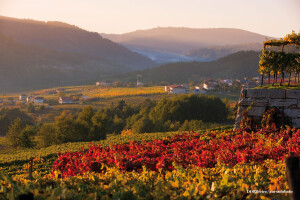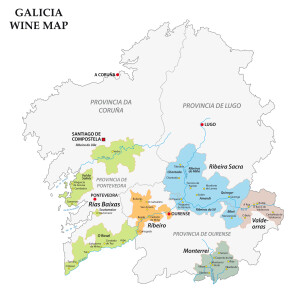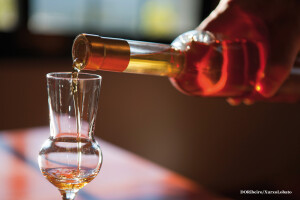The Ribeiro DO—the oldest appellation in Galicia—was established in 1932. The region sits between the of O Rosal sub-region of Rías Baixas (to the west) and the Ribeira Sacra DO (to the east). The area is located along the eastern banks of the Miño (Minho) River, about 30 km/48 miles inland of the Atlantic Ocean.
Ribeiro, a cool-to-moderate climate region, is part of Green Spain—the area of northwest Spain exposed to the influence of the Atlantic Ocean. The area is surrounded by rolling hills, criss-crossed by rivers, and tucked between the coastal plains and the mountains of the Galician Massif.
The region—heavily planted to white grapes—has been known for the quality of its wines since the 12th century, when the monks of San Clodio Monastery served their wines to travelers and pilgrims on the nearby Camino. Documentation from the time (dated 1133) shows that the wines of Ribeiro were the most highly prized—and expensive—wines served in the nearby town of Santiago de Compostela.
These days, about 90% of the production of the Ribeiro DO is white wines. Treixadura—the leading white grape variety—is often referred to as the “jewel of the Ribeiro.” Other highly regarded white grape varieties include Torrontés, Godello, Albariño, Loureira, Lado and Caíño Blanco; Palomino and Albillo are allowed as well. The white wines of the Ribeiro DO are often enjoyed as young, vibrant, and expressive white wines; aged versions are appreciated for their elegance and subtlety.
Another 9% of the production is red wines—crisp and bright—produced mainly from Caíño Longo, Caíño Bravo, Caíño Tinto, Ferrón, Sousón, Mencía, and Brancellao grape varieties. (Tempranillo and Alicante Bouschet are allowed as well.)
The Ribeiro DO also allows for the production of a naturally sweet, dried-grape wine known as Ribeiro Tostado (“toasted”). Grapes—which may be either white or red—used in the production of Ribeiro Tostado are dried (after harvest) for a minimum of three months. After fermentation, the wine must be aged for a minimum of six months in oak or cherry vats; this must be followed by at least three months of aging in the bottle. Production of this rich, complex, and luscious wine is very small and labor-intensive.
Advanced students of wine might be interested to know that in 2017, the Consejo Regulador of the Ribeiro DO granted approval for some changes to the rules and regulation of the appellation. This amendment was recently approved by the EU; the updated Pliego de Condiciones was published in the Official Journal of the EU on November 18, 2020.
As a result of the changes, the standards of the Ribeiro DO now allow for the production of sparkling wines. The changes also tightened several of the quality standards for the wines, such as maximum yields, planting density, and minimum ripeness levels. (See the attached documentation for details.)
The newly-defined standards for the sparkling wines of the region—Vinos Espumosos de Calidad Ribeiro—require that the wines be produced using the traditional method, with a minimum of 9 months aging on the lees. Ribeiro Espumoso may be produced as a white (blanco) or rosé (rosado) wine; however, it must be dry—brut (maximum sugar of 12 g/L) and brut nature (maximum sugar of 3 g/L) are the only sweetness levels allowed.
The updates also provide for the use of the term barrica on wines that have spent some time in oak barrels (of 600 liters/maximum capacity) at any point in the production process. While the minimum time in oak is not specified, wines labeled with the term barrica (Ribeiro Barrica Blanco or Ribeiro Barrica Tinto) must demonstrate a “woody aromatic character” (to include aromas of toast, spice, and balsam) balanced by aromas and flavors of fruit, flowers, honey, jam, and herbs.
References/for more information:
- Ribeiro DO Pliego de Condiciones-Nov 2019
- Ribeiro Amendment Proposal EU publication
- https://www.ribeiro.wine/our-wines
- Wine map of Galicia created by Rainer Lesniewski, via 123rf (dot) com
Post authored by Jane A. Nickles…your blog administrator: jnickles@societyofwineeducators.org


